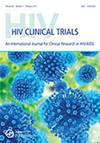Dual Raltegravir–Darunavir/Ritonavir Combination in Virologically Suppressed HIV-1-Infected Patients on Antiretroviral Therapy Including a Ritonavir-Boosted Protease Inhibitor Plus Two Nucleoside/Nucleotide Reverse Transcriptase Inhibitors
Q2 Medicine
引用次数: 11
Abstract
Background: Nucleoside reverse transcriptase inhibitor (NRTI)-sparing antiretroviral therapies may be useful in HIV-infected patients with resistance or intolerance to this class. Methods: We performed an observational study of patients on suppressive antiretroviral therapy containing two NRTIs plus one ritonavir-boosted protease inhibitor who switched to a dual regimen containing raltegravir (400 mg twice daily) and darunavir/ritonavir (800/100 mg once daily) and were followed-up for 48 weeks. Results: As a whole, 82 patients were enrolled. Mean duration of current regimen was 4.6 years and mean duration of plasma HIV RNA < 50 copies/mL before the switch was 46.2 months. Reason for simplification was toxicity in 76 patients and resistance to NRTIs in 13. After switching, the percentage of patients with HIV RNA < 50 copies/mL at week 48 was 92.7% in the intent-to-treat-exposed analysis and 97.6% in the per-protocol analysis. The switch led to a significant reduction in the mean triglyceride value (−85.2 mg/dL), in the prevalence of tubular proteinuria (−56%) and in the mean level of interleukin-6 (−0.94 pg/mL), with a significant increase in the mean phosphoremia (+0.58 mg/dL). Mean trough concentrations of both raltegravir and darunavir were within the therapeutic range. Two patients (2.4%) had virological failure due to suboptimal adherence and 4 subjects (4.9%) discontinued treatment due to adverse events, but no patients experienced Grade 3 or 4 adverse events. Conclusion: In our study, simplification to a dual therapy containing raltegravir plus darunavir/ritonavir after 48 weeks maintained viral suppression in more than 90% of patients and showed a good tolerability with a favourable effect on proteinuria, ipophosphoremia, and lipid metabolism.双重雷替格拉韦-达若那韦/利托那韦联合治疗在病毒学上抑制hiv -1感染患者的抗逆转录病毒治疗,包括利托那韦增强蛋白酶抑制剂加两种核苷/核苷酸逆转录酶抑制剂
背景:保留核苷逆转录酶抑制剂(NRTI)的抗逆转录病毒疗法可能对耐药或不耐受的hiv感染患者有用。方法:我们进行了一项观察性研究,患者在接受含有两种NRTIs加一种利托那韦增强蛋白酶抑制剂的抑止性抗逆转录病毒治疗后,切换到含有雷替韦(400 mg,每日2次)和达那韦/利托那韦(800/100 mg,每日1次)的双重治疗方案,并随访48周。结果:共纳入82例患者。当前方案的平均持续时间为4.6年,转换前血浆HIV RNA < 50拷贝/mL的平均持续时间为46.2个月。简化的原因是76例患者中毒,13例患者对NRTIs耐药。转换后,48周时HIV RNA < 50拷贝/mL的患者百分比在意向暴露分析中为92.7%,在方案分析中为97.6%。该转换导致甘油三酯平均值(- 85.2 mg/dL)、管状蛋白尿患病率(- 56%)和白细胞介素-6平均水平(- 0.94 pg/mL)显著降低,平均磷血症显著增加(+0.58 mg/dL)。雷替格拉韦和达那韦的平均波谷浓度均在治疗范围内。2名患者(2.4%)由于依从性不佳而出现病毒学失败,4名患者(4.9%)由于不良事件而停止治疗,但没有患者出现3级或4级不良事件。结论:在我们的研究中,简化为雷替重力韦加达鲁那韦/利托那韦的双重治疗48周后,90%以上的患者保持了病毒抑制,并表现出良好的耐受性,对蛋白尿、肝磷血症和脂质代谢有良好的影响。
本文章由计算机程序翻译,如有差异,请以英文原文为准。
求助全文
约1分钟内获得全文
求助全文
来源期刊

HIV Clinical Trials
医学-传染病学
CiteScore
1.76
自引率
0.00%
发文量
0
审稿时长
>12 weeks
期刊介绍:
HIV Clinical Trials is devoted exclusively to presenting information on the latest developments in HIV/AIDS clinical research. This journal enables readers to obtain the most up-to-date, innovative research from around the world.
 求助内容:
求助内容: 应助结果提醒方式:
应助结果提醒方式:


